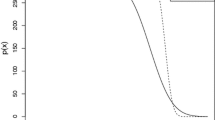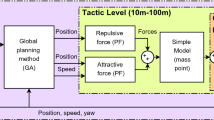Abstract
Until recently, local governments in Spain were using machines with rolling cylinders for verifying taximeters. However, the condition of the tires can lead to errors in the process and the mechanical construction of the test equipment is not compatible with certain vehicles. Thus, a new measurement device needs to be designed. In our opinion, the verification of a taximeter will not be reliable unless measurements taken on an actual taxi run are used. GPS sensors are intuitively well suited for this process, because they provide the position and the speed with independence of those car devices that are under test. But there are legal problems that make difficult the use of GPS-based sensors: GPS coordinate measurements do not match exactly real coordinates and, generally speaking, we are not given absolute tolerances. We can not know whether the maximum error is always lower than, for example, 7 m. However, we might know that 50% of the measurements lie on a circle with a radius of 7 m, centered on the real position. In this paper we describe a practical application where these legal problems have been solved with soft computing based technologies. In particular, we propose to characterize the uncertainty in the GPS with fuzzy techniques, so that we can reuse certain recent algorithms, formerly intended for being used in genetic fuzzy systems, to this new context. Specifically, we propose a new method for computing an upper bound of the length of the trajectory, taking into account the vagueness of the GPS data. This bound will be computed using a modified multiobjective evolutionary algorithm, which can optimize a fuzzy valued function. The accuracy of the measurements will be improved further by combining it with restrictions based on the dynamic behavior of the vehicles.













Similar content being viewed by others
References
Abbasbandy S, Asady B (2006) Ranking fuzzy numbers by sign distance. Inform Sci 176:2405–2416
Anile AM, Falcidieno B, Gallo G, Spagnuolo M, Spinello S (2000) Modeling uncertain data with fuzzy B-splines. Fuzzy Sets Syst 113:397–410
Berman P, Schnitger G (1992) On the complexity of approximating the independent set problem. Inform Comput 96:77–94
Buzer L (2009) Optimal simplification of polygonal chains for subpixel-accurate rendering. Comput Geom 42(1):45–59
Casillas J, Cordón O, del Jesus MJ, Herrera F (2001) Genetic tuning of fuzzy rule-based systems integrating linguistic hedges. In: Proceedings of the 9th IFSA world congress and 20th NAFIPS international conference, Vancouver, pp 1570–1574
Chen DZ, Daescu O, Hershberger J, Kogge PM, Mi N, Snoeyink J (2005) Polygonal path simplification with angle constraints. Comput Geom 32(3):173–187
Couso I, Montes S, Gil P (2001) The necessity of the strong alpha-cuts of a fuzzy set. Int J Uncertain Fuzziness Knowl Based Syst 9(2):249–262
Cressie NAC (1991) Statistics for spatial data. Wiley, London. ISBN 0-471-84336-9
de Boor C (1972) On calculating with B-splines. J Approx Theory 6:50–62
Deb K, Goel T (2001) Controlled elitist non-dominated sorting genetic algorithms for better convergence. In: Zitzler E, Deb K, Thiele L, Coello CAC, Corne D (eds) First international conference on evolutionary multi-criterion optimization. Springer, Heidelberg, LNCS No. 1993, pp 67–81
Deb K, Agrawal S, Pratab A, Meyarivan T (2000) A fast elitist non-dominated sorting genetic algorithm for multi-objective optimization: NSGA-II. In: Schoenauer M, Deb K, Rudolph G, Yao X, Lutton E, Merelo JJ, Schwefel HP (eds) Proceedings of the parallel problem solving from nature VI conference. Springer, Heidelberg, pp 849–858
Drysdale RLS, Rote G, Sturm A (2008) Approximation of an open polygonal curve with a minimum number of circular arcs and biarcs. Comput Geom 41(1–2):31–47
Dussault C, Courtois R, Ouellet JP, Huot J (2001) Influence of satellite geometry and differential correction on GPS location accuracy. Wildl Soc Bull 29(1):171–179
Estkowski R, Mitchell JSB (2002) Simplifying a polygonal subdivision while keeping it simple, SCG ’01. In: Proceedings of the seventeenth annual symposium on computational geometry, ISBN 1-58113-357-X, 40-49, ACM Press, New York
Ganesan K, Veeramani P (2006) Fuzzy linear programming with trapezoid fuzzy numbers. Ann Oper Res 143:305–315
Goodman IR, Nguyen HT (1985) Uncertainty models for knowledge-based systems. Elsevier, New York
Grewal MS, Weill LR, Andrews AP (2007) Global positioning systems, inertial navigation, and integration, 2nd edn. Wiley, London. ISBN: 978-0-470-04190-1.
Gudmundsson J, Narasimhan G, Smid M (2007) Distance-preserving approximations of polygonal paths. Comput Geom 36(3):183–196
Hershberger J, Snoeyink J (1992) Speeding up the douglas-peucker line simplification algorithm. In: Proceedings of the 5th international symposium on spatial data handling, Charleston, pp 134–143
Hofmann-Wellenhof B, Collins L (2004) GPS theory and practice. Springer, Heidelberg, ISBN 3211835342
Hsu JC (1996) Multiple comparisons: theory and methods. Chapman and Hall, London
Jahanshahloo GR, Soleimani-damaneh M, Nasbaradi E (2004) Measure of efficiency in DEA with fuzzy input-output levels: a methodology for assessing, ranking and imposing of weight restrictions. Appl Math Comput 156:175–187
Kiyota T, Tsuji Y, Kondo E (2000) New multiobjective fuzzy optimization method and its application. In: American control conference ACS’2000 6, Chicago, pp 4224–4228
Lachapelle G, Ryan S (2000) Statistical reliability measures for GPS. In: IMA workshop on mathematical challenges in GPS University of Minnesota, August 16–18
Langley RB (1991) The mathematics of GPS. GPS World 2(7):45–59
Langley RB (1999) Dilution of precision. GPS World 10(5):52–59
Li L, Chen W (1999) Corner detection and interpretation on planar curves using fuzzy reasoning. IEEE Trans Pattern Anal Mach Intell 21(11):1204–1210
Mitchell HB (2006) Ranking type-2 fuzzy numbers. IEEE Trans Fuzzy Syst 14(2):287–294
Mosavi MR, Mohammadi K, Refan MH (2002) Fuzzy processing on GPS data to improve positioning accuracy, before and after S/A Is turned off. In: The Asian GPS conference, India, pp117–120
Naranjo J, González C, García R, de Pedro T (2007) Fuzzy logic for transportation guidance: developing fuzzy controllers for maintaining an inter-vehicle safety headway. In: Bai Y, Zhuang H, Wang D (eds) Advances in industrial control, advanced fuzzy logic technologies in industrial applications. Springer, London, pp 129–143
Otero J, Sanchez L, Alcala-Fdez J (2008) Fuzzy-genetic optimization of the parameters of a low cost system for the optical measurement of several dimensions of vehicles. Soft Comput 12(3):751–764
Quddus MA, Noland RB, Ochieng WY (2006) A high accuracy fuzzy logic based map matching algorithm for road transport. J Intell Transport Syst 10(3):103–115
Sánchez L, Couso I (2007) Advocating the use of imprecisely observed data in genetic fuzzy systems. IEEE Trans Fuzzy Syst 15(4):551–562
Sánchez L, Couso I, Casillas J (2006) A multiobjective genetic fuzzy system with imprecise probability fitness for vague data. In: Second international symposium on evolving fuzzy systems 2006 (EFS06), Ambleside Lake District, pp 131–137
Sánchez L, Couso I, Casillas J (2007) Modeling vague data with genetic fuzzy systems under a combination of crisp and imprecise criteria. In: First IEEE symposium on computational intelligence in multi-criteria decision-making (MCDM 2007), Honolulu
Sánchez L, Couso I, Casillas J (2009) Genetic learning of fuzzy rules based on low quality data. Fuzzy Sets Syst (submitted)
Sheen JN (2006) Fuzzy evaluation of cogeneration alternatives on a petrochemical industry. Comput Math Appl 49:741–755
Strang G, Borre K (1997) Random variables and covariance matrices. In: Linear algebra, geodesy, and GPS. Wellesley-Cambridge Press, Massachusetts
Snyder JP (1982) Map projections used by the U.S. geological survey. Geol. Survey Bulltein 1532. U.S. Government Printing Office, Washington
Sun H, Wu J (2006) A new approach for ranking fuzzy numbers based on fuzzy simulation analysis method. Appl Math Comput 174:755–767
Tran L, Duckstein L (2002) Comparisions of fuzzy numbers using a fuzzy distance measure. Fuzzy Sets Syst 130:321–341
Trebi-Ollennu A, White BA (1997) Multiobjective fuzzy genetic algorithm optimization approach to nonlinear control system design. IEEE Proc Control Theory Appl 2(144):137–142
van Diggelen F (2007) GNSS accuracy: Lies, Damn Lies, and statistics. GPS World 9(1):41–45
Wang Y-M, Greatbanks R, Yang J-B (2005) Interval efficiency assessment using data envelopment analysis. Fuzzy Sets and Syst 153:347–370
Yeh C-H, Deng H (2004) A practical approach to fuzzy utilities comparision in fuzzy multicriteria analysis. Int J Approx Reason 35:179–194
Youssef H, Sait SM, Khan A (2000) Fuzzy simulated evolution algorithm for topology design on campus networks. In: Congress on evolutionary computation 1, Piscataway, pp 180–187
Sun Z, Dong T, Liao X, Zhang R, Song D (2007) Fuzzy logic for flight control II: fuzzy logic approach to path tracking and obstacles avoidance of UAVs. In: Bai Y, Zhuang H, Wang D (eds) Advances in industrial control, advanced fuzzy logic technologies in industrial applications. Springer, London, pp 223–235
Zheng G, Zhao R, Guo Q, Liu L, Bai L, Du L (2006) Adaptive avoiding divergence algorithm for GPS/DR integration based on fuzzy logic. Intelligent control and automation, 2006. WCICA 2006. In: The sixth world congress, vol 2, 21–23 June 2006, pp 8679–8682
Acknowledgments
This work was funded by Spanish Min. of Education, under the grant TIN2005-08386-C05-05, TIN2008-06681-C06-04 and ITVASA.
Author information
Authors and Affiliations
Corresponding author
Rights and permissions
About this article
Cite this article
Villar, J., Otero, A., Otero, J. et al. Taximeter verification with GPS and soft computing techniques. Soft Comput 14, 405–418 (2010). https://doi.org/10.1007/s00500-009-0414-4
Published:
Issue Date:
DOI: https://doi.org/10.1007/s00500-009-0414-4




